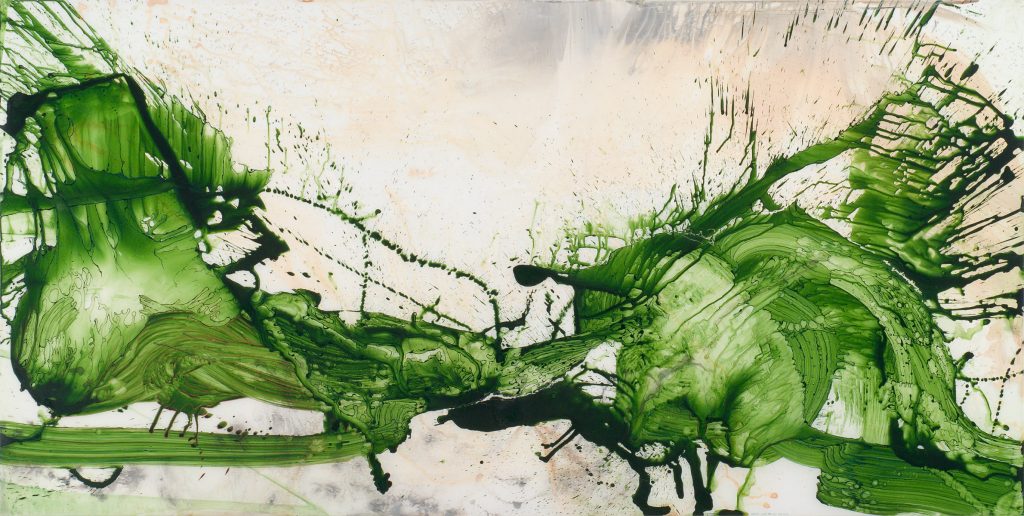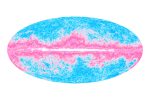
Catalog essay from “Pouring it On” exhibition, University of Massachusetts, Amherst
Most of the artists in Pouring it On do just this: apply paint in loose and generous ways on top of surfaces sturdy enough to support it. They also paint on. And on. Taking cues from abstract expressionism, color field, finish-fetish, hard-edge abstractionism, neo-geo and the like, these artists not only work from this lineage, they actually work upon it, as if the very layers of paint themselves embed the lineage that painting has assumed. That the doors of painting as practice and material are now so widely open is evident within the range of material processes, canny strategies, and sheer sensual pleasure presiding over this exhibition.
Matthew Kolodziej’s work germinates from familiar walks taken in and around Cleveland, Ohio—where he lives and works—usually from building sites he describes as “places of transition.” Like an architect or builder, the artist constructs these paintings in various stages that begin with photographic records of these meanderings. This photographic documentation is projected up onto canvases, traced, then systematically worked until the paintings reach a point of “fullness” – something that is not predetermined by the artist. The surfaces of his paintings are embossed the way a foot treading on the ground might leave an imprint. His paintings draw a link between the impression the weight of the human body imparts into the ground and the touch of the hand making a painted mark on the canvas. Raised lines appear as he pipes by squeezing gel medium out of bags used by pastry chefs. Into these lines he pours rivulets of paint that puddle and coalesce. Upon drying, the work is then sanded and repainted, layers simultaneously revealing and concealing. Initially applied heavy doses of paint are chipped away at, unearthed, producing an “archaeology” of painting. The resultant works echo certain works of George Condo, particularly the busy Cascading Butlers from 2011 or Black and Red Compression from 2011. Or like a “geometric” Arshile Gorky, Kolodziej clearly acknowledges the painting history within which his work is steeped while viscerally digging out his own path.
Like Kolodziej, Summer Wheat playfully applies paint to her canvases with tools traditionally used for domestic rather than artistic tasks. Despite being the only “figurative” artist in the show, her work comfortably and strategically straddles the objective and non-objective, a place where many contemporary painters willfully and successfully stake their claim. On initial viewing, Wheat’s imagery is wistful and emotive: suggestive of doll’s heads, children’s drawings. But the ramped-up paint application imparts an unexpected and urgent physicality to the work; what may be perceived as endearing is abruptly transformed into mask-like totemic or haunting symbols. Her earthy palette actually suggests mid-20th century British painters such as Leon Kossoff or Frank Auerbach, but her startling, esoteric paint application makes the work truly her own.
Leslie Wayne doesn’t just pour, she slathers, scrapes, cuts, peels, shaves, sculpts, rolls. She transforms paint into wedges, blobs, and strips that are either directly applied to a surface or made ahead of time, cut out, and adhered, at a later stage, into wet oil paint. There is an incredible heft to her work that creates a “geography” or “terrain” of paint. Wayne describes the physical swathes of material as “the color and the form becoming one and the same.” In this sense, there is a purposeful lack of illusion in her work. A self-described “process painter,” Wayne is less concerned with depictions as she is with physical, actualized descriptions of organic matter around us, everything from rock strata to fancily piped icing, from billowing fabrics to Gaudi’s architecture.
Her work nods toward some of the gestural sweeping of a Willem de Kooning, Hans Hoffman, or Franz Kline, but as she says herself, “I have focused on condensing the expansive arena of heroic painting into a tiny format, forcing a shift between size and scale, as if the world were on a thimble.” An emphasis on the sensual, even decorative, properties of paint, evident in works such as The Mouth that Roared from 2000 and the Touch of Beatriz from 1999, adds meaning to her work not apparent in the work of the aforementioned male painters. Terms such as “patter” and “decoration” can be applied to her work free of the pejorative meaning associated with them thirty years ago. Wayne’s work seems to beg of us to be seduced by its physical presence, unabashed lushness, and beauty.
Upon first viewing of a Tomory Dodge painting, one is visually arrested by a cascade of brushstrokes. In Mumblecore, from 2012, Dodge employs some strategies reminiscent of Jasper Johns’ “chevron” paintings in their vertical symmetry, allover pattern, and composition. From 2007 until the present day, Dodge’s work has become increasingly abstract. He has also added to his repertoire of applying paint. Dodge smartly and self-consciously embraces the “smorgasbord” that is contemporary painting. In an interview from the blog, “Painter’s Table,” he states, “I like the formal tension that comes from the inclusion of different approaches to painting on one surface.” These myriad “styles” employed on the same canvas include: scraping, squeegeeing, wet-into-wet, dry brushing that resembles airbrushing, layering, pouring, and staining—all the tropes of 1960’s Modernist abstraction employed to full force yet freed from the autonomy or purity of form sought by Clement Greenberg and the painters of the time. Dodge’s work, such as the 2006 Levitate, a gigantic 84” x 168” canvas, are a kaleidoscope of vibrant and splintered marks fanning out, falling down, exploding, and swirling around the picture plane. Looking at a Josh Smith painting is an emotively charged experience. There is a restless vitality to the way Josh Smith’s work challenges the notion of authorship through diverse imagery and styles. Sometimes intentionally clunky and raw, other times deft with a quicksilver touch, his work celebrates the possibilities of making images while highlighting the seriousness of this pursuit. One work, Untitled, a 30” x 24” oil on canvas from 2011, is a beautiful interplay of red and green complements, gestural, swirling paint, and lush, loose surfaces that recalls the German painter, Rainer Fetting’s 1978 Drummers and Guitarists and his 1981 canvas, Ricky Blau. Smith resists assigning specific narratives by leaving all of his work untitled. Like most of the painters in the show, his motivations and interests appear to lie more in the physical properties and history of painting from which he is able to draw so voraciously.
Cathy Choi draws attention to her method of pouring by enabling the lush, glossy paint mixed with latex and glue to pool and congeal at the bottom edge of the canvas. The materiality of the process or act of making is made self-evident. Her choice of resin and glue produces a surface sheen that cleverly reflects other paintings hanging in the periphery, as if the paintings themselves were looking around the gallery. Seeing paintings reflected in other paintings is also a wry commentary about the self-referential, historicized nature of painting. These slick surfaces, coupled with Choi’s “candy” palette recall the “Finish-Fetish” painters of Southern California, as well as materialism, commerce, and the fabricated forms of Donald Judd. The artist, however, cites de Kooning and the Abstract Expressionists as major influences, but lately her work seems more influenced by the natural world, in particular the movement and surface of water. Perhaps this is reflected in her choice of resin and clear-drying glue, which simulates the transparency and glass-like surface of water. Choi’s process-driven methodology recalls Wayne’s in this statement: “the process itself becomes a driving force that flows from within and becomes an innate response with no predetermined end.”
The recurring splash motif that crops up in many of Jonathan Feldschuh’s work seems to come directly from the hand dropping pigment from a huge house-painting brush loaded with paint. In fact, the image is derived from his research into various scientific experiments, such as the “Ligament Mediated Drop Formation,” or the “Mach Wave Radiation from a Jet.” The latter is described on Feldschuh’s website as being a “benchtop simulation of a problem in fluid dynamics.” Ironically, this description of the scientific experiment could actually be describing the phenomena of paint, particularly the term, “fluid dynamics.”
Feldschuh equates the material interaction in the scientific image with the painterly pour, gesture, or splash. Even though they appear to be masculine and gestural, they are actually driven by material processes found in scientific phenomena. His work is reminiscent of David Reed’s horizontal, “flattened” gestural paintings that also called into question the nature of gesture, albeit in a very different way. On first glance, other “pouring” painters like Larry Poons or Helen Frankenthaler come to mind, but Feldschuh works his images by embedding them in layers of gel medium or outlining the splashes themselves, producing a slowed-down, less “passionate” or heroic affect than these earlier Modern painters.
